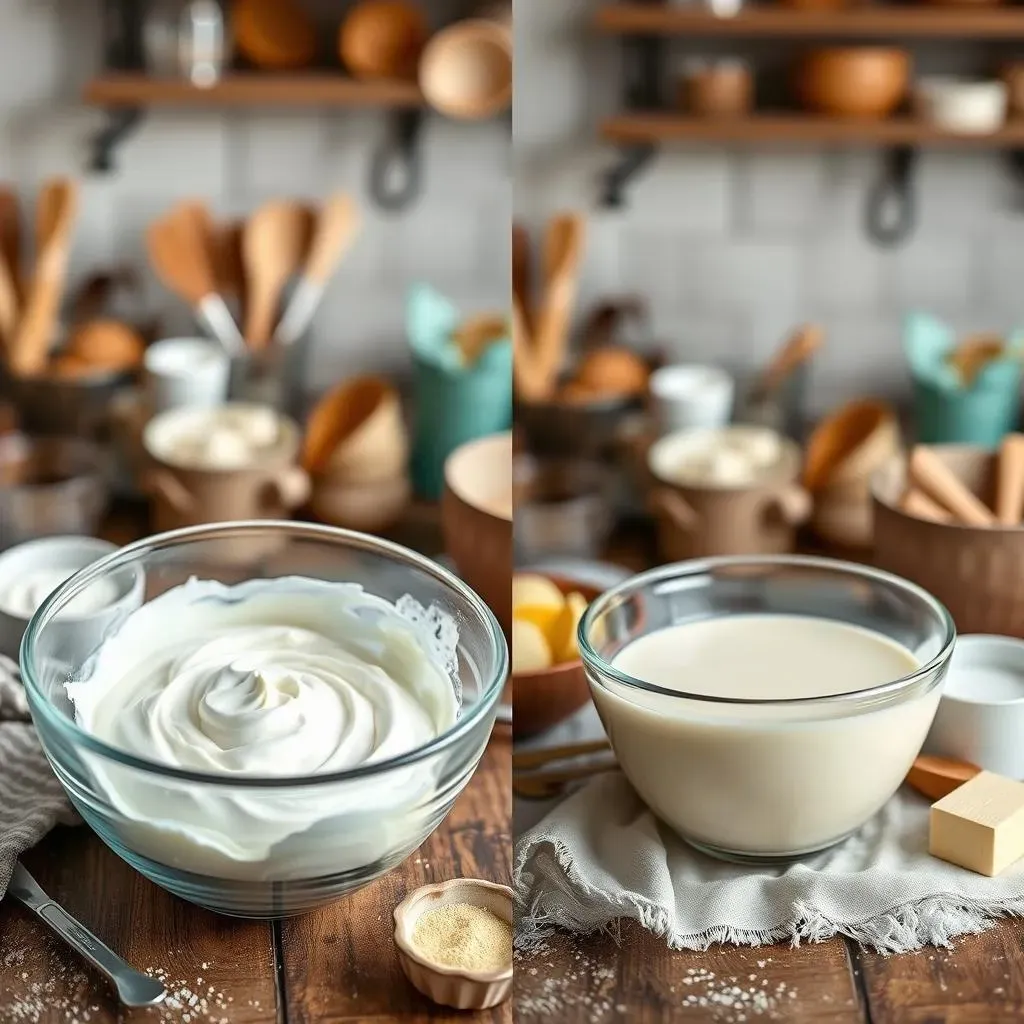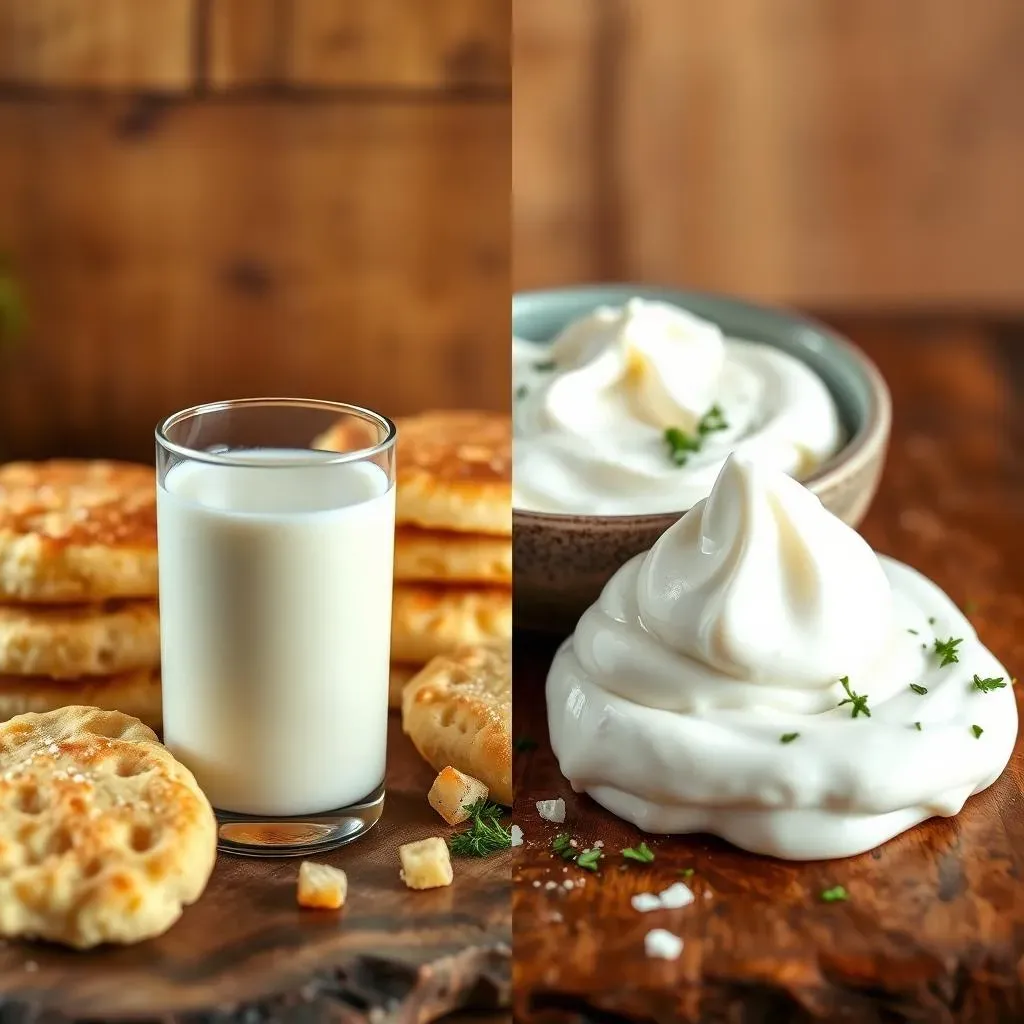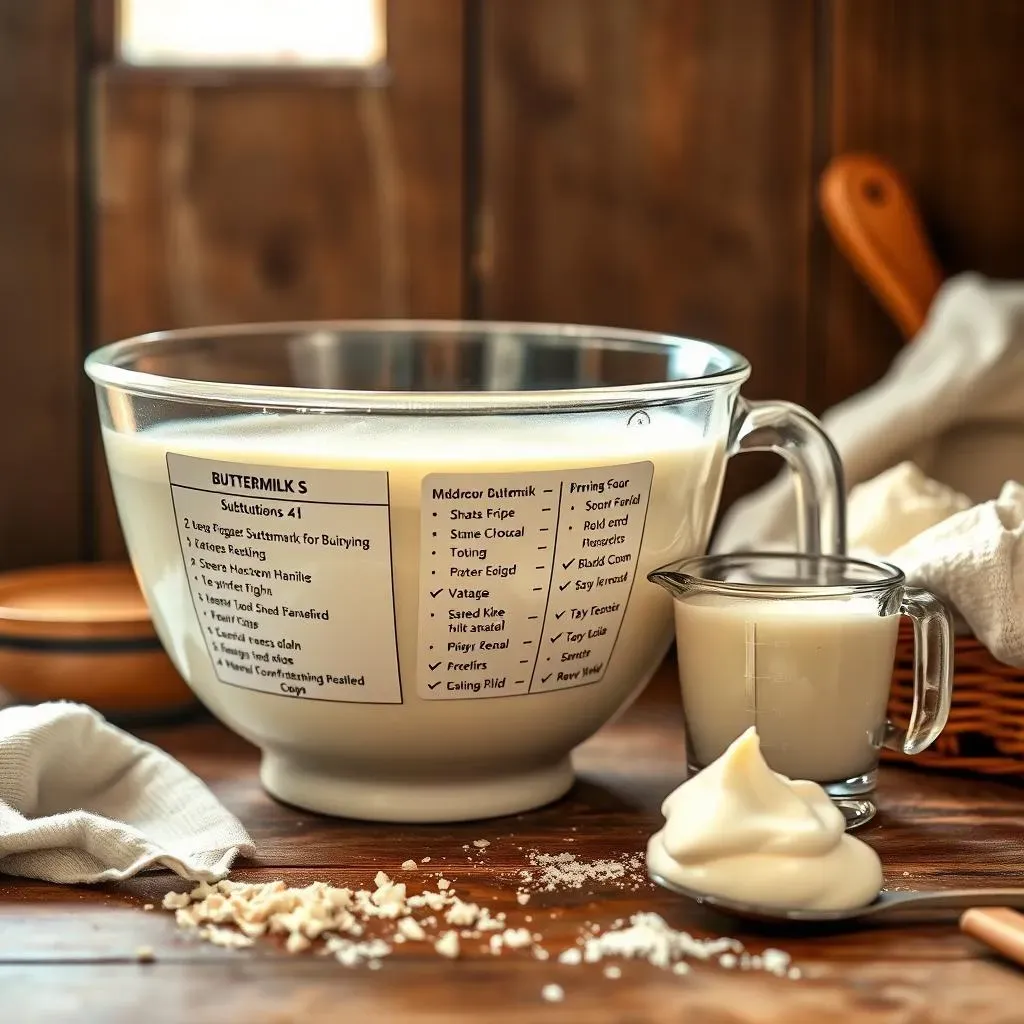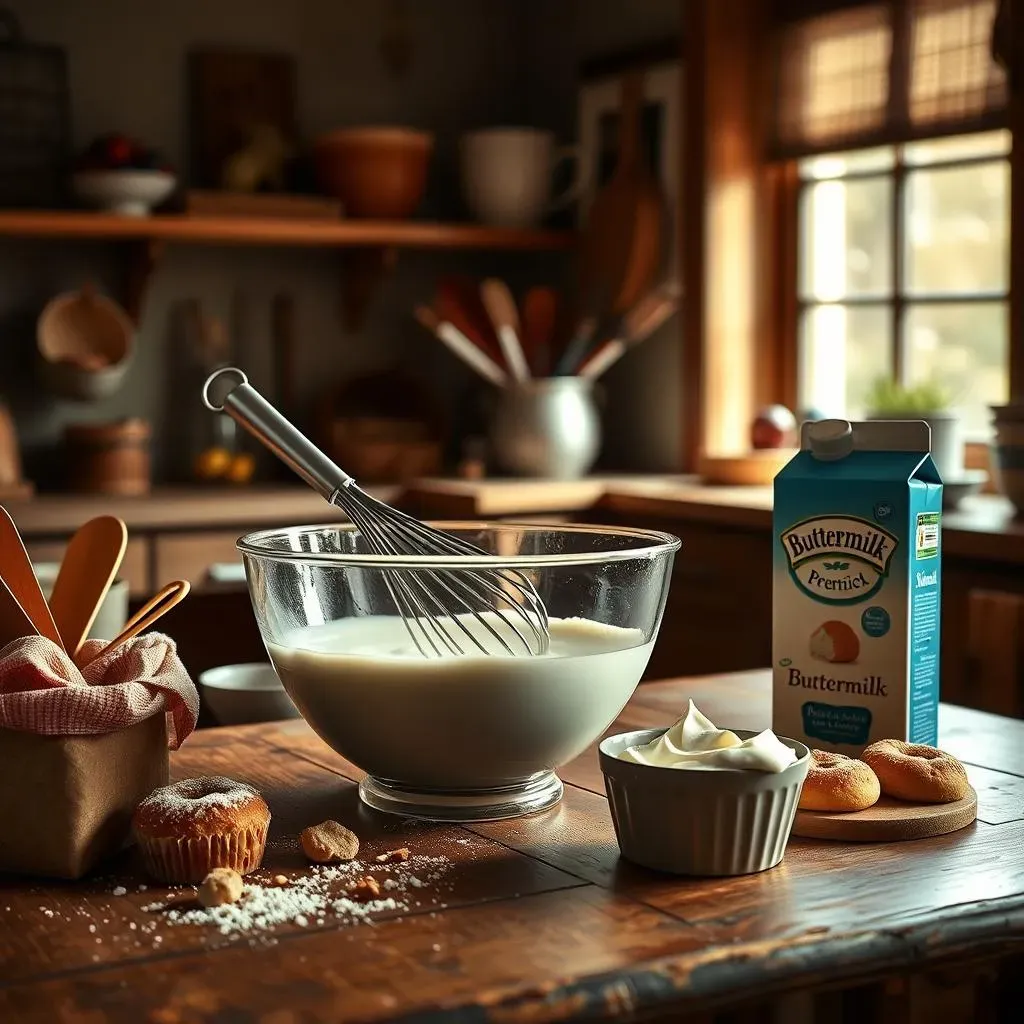Table of Contents
Ever stared blankly at a recipe, realizing you're missing a key ingredient – sour cream, perhaps? And your pantry's overflowing with buttermilk? Don't despair! This article tackles the burning question: can you substitute buttermilk for sour cream? We'll explore the nuances of this common baking dilemma, guiding you through the differences between these two tangy dairy products. Understanding their unique properties is key to successful substitutions. We'll then dive into practical, real-world examples, showing you exactly how to make the swap in various recipes, from cakes and pancakes to dips and sauces. We'll also offer valuable tips and tricks to ensure your baking triumphs, not fails. Whether you're a seasoned baker or a kitchen novice, this guide will empower you to confidently navigate substitutions and create delicious results. Get ready to unlock the secrets of successful baking – let's explore the world of buttermilk and sour cream together!
Can You Substitute Buttermilk for Sour Cream in Baking?

Can You Substitute Buttermilk for Sour Cream in Baking?
The Great Dairy Debate: Buttermilk vs. Sour Cream
So, you're staring at a recipe, and it calls for sour cream. But your fridge is sadly lacking. You do, however, have a carton of buttermilk. Can you substitute? The short answer is: sometimes! It's not a direct one-to-one swap, though. Both buttermilk and sour cream bring acidity and richness to baked goods, but they differ in texture and fat content. Sour cream is thicker and creamier, while buttermilk is thinner and more tangy. This means a straight swap might lead to a drier or wetter cake, a less rich sauce, or even a completely different flavor profile. The success of your substitution depends heavily on the recipe and what role the sour cream plays in it.
Think of it like this: sour cream is the velvet cushion, adding richness and a smooth texture. Buttermilk, on the other hand, is the zesty lemon, bringing a bright, tangy kick. While both enhance a dish, their roles are distinct. A recipe relying on sour cream's creamy texture, like a frosting, might not fare well with a buttermilk substitution. However, in recipes where the acidity is the star, such as quick breads or pancakes, buttermilk might be a surprisingly good alternative. Let's look at how to make the swap successfully.
Ingredient | Role in Baking | Buttermilk Substitution? |
|---|---|---|
Sour Cream | Adds richness, creaminess, moisture | Sometimes, with adjustments |
Buttermilk | Adds tang, moisture, tenderizes | Often a good substitute for sour cream (with modifications) |
Making the Switch: A Recipe-Specific Approach
The key to successfully substituting buttermilk for sour cream is understanding the specific recipe. If the sour cream is primarily for moisture and richness, you'll need to compensate for the thinner consistency of buttermilk. You might need to add a bit of extra fat, such as melted butter or oil, to get the desired texture. If the sour cream is there for its tang, buttermilk might be a great fit, potentially even enhancing the flavor. However, be aware that the overall flavor might shift slightly. Remember that buttermilk is more acidic than sour cream, so you might need to reduce other acidic ingredients in the recipe to avoid an overly tart result.
For instance, in a cake recipe, you might substitute ¾ cup of buttermilk for 1 cup of sour cream, adding 1-2 tablespoons of melted butter to make up for the lost fat. In a savory dish, a simple swap might work well, especially if the recipe already features other bold flavors. However, always start with a small substitution and taste-test before committing to the full amount. A little experimentation is key to finding the perfect balance. Remember: baking is a science! Experimentation is part of the fun. Don't be afraid to try it and see what happens.
- Start with a smaller substitution.
- Adjust based on texture and taste.
- Don't be afraid to experiment!
Understanding the Differences: Buttermilk vs. Sour Cream

Understanding the Differences: Buttermilk vs. Sour Cream
Buttermilk: The Tangy Friend
Let's talk buttermilk first. It's not just milk that's gone a bit sour; it's actually a cultured dairy product. Think of it as milk that's had a party with friendly bacteria. This fermentation process gives it that signature tangy flavor and slightly thicker consistency. Buttermilk is lower in fat than sour cream, and its thinner texture makes it a great choice for adding moisture and tenderness to baked goods. It's a secret weapon for fluffy pancakes and tender biscuits.
The acidity in buttermilk is what really sets it apart. It reacts with baking soda (or baking powder) to create those lovely little air pockets that give baked goods their light and airy texture. It's also a fantastic tenderizer, breaking down gluten and creating a softer crumb. So, if you need a boost of tang and a tender texture, buttermilk is your friend!
- Cultured dairy product
- Tangy flavor
- Lower in fat than sour cream
- Thinner texture
- Great tenderizer
Sour Cream: The Creamy Heavyweight
Now, let's meet sour cream. This is a thicker, richer cousin to buttermilk. It's made by fermenting cream, resulting in a higher fat content and that signature creamy texture. This makes it ideal for adding richness, moisture, and a smooth, luxurious mouthfeel to baked goods and savory dishes. Think of it as the ultimate creamy addition to your dips, frostings, or even soups.
While sour cream also possesses acidity, it's less pronounced than buttermilk's. Its primary role is often to add richness and body, rather than providing a significant leavening effect. Therefore, when substituting, consider that you’ll be losing that creamy texture and intense richness if you use buttermilk. You might need to compensate by adding extra fat or moisture to your recipe.
Feature | Buttermilk | Sour Cream |
|---|---|---|
Fat Content | Lower | Higher |
Texture | Thinner | Thicker |
Acidity | Higher | Lower |
Primary Role in Baking | Tenderizing, leavening | Richness, moisture |
Successful Substitutions: Buttermilk for Sour Cream Recipes

Successful Substitutions: Buttermilk for Sour Cream Recipes
Successful Substitutions: Buttermilk for Sour Cream Recipes
Alright, let's get down to the nitty-gritty: actually *using* buttermilk in place of sour cream. It's not a magic bullet, but with a little know-how, you can achieve surprisingly good results. The key is understanding *why* the sour cream is in the recipe in the first place. Is it for richness and creaminess? Or is it primarily for its tangy bite? If it's for richness, you'll need to compensate for the thinner consistency of buttermilk. A simple one-to-one swap won't cut it. You'll likely need to add something to boost the richness – think melted butter, a little extra oil, or even a dollop of mayonnaise (don't judge until you've tried it!). If the sour cream's mainly for tang, a simple swap might work beautifully, adding a slightly different, but still delicious, flavor profile. Remember to always taste-test along the way; baking is an iterative process!
Let's look at some examples. In a cake recipe, you might replace 1 cup of sour cream with ¾ cup buttermilk plus 2 tablespoons of melted butter. This will help maintain the moisture and richness, whilst introducing a slightly tangier note. In a creamy soup or dip, you could try a similar ratio, but be prepared to adjust the consistency with a little extra liquid if needed. For pancakes or muffins, a straight swap might be perfectly acceptable, or even preferable, as the buttermilk’s tanginess will complement these baked goods beautifully. The beauty of baking (and cooking!) is the experimentation. Don't be afraid to tweak and adjust until you find your perfect balance.
Recipe Type | Buttermilk Substitution Ratio | Additional Considerations |
|---|---|---|
Cakes | ¾ cup buttermilk for 1 cup sour cream | Add 1-2 tbsp melted butter or oil |
Pancakes/Muffins | 1:1 ratio | May enhance tanginess |
Soups/Dips | ¾ cup buttermilk for 1 cup sour cream | Adjust consistency with extra liquid |
Remember, though, that even with careful substitutions, the final product might not be *exactly* the same. Buttermilk’s higher acidity and thinner texture will alter the taste and texture somewhat. This isn't necessarily a bad thing! It can lead to exciting new flavor combinations. Think of it as an opportunity for culinary exploration. The best way to learn is to experiment! Start small, taste as you go, and don't be discouraged if your first attempt isn't perfect. That's all part of the fun.
One final tip: If you're working with a particularly precious or complex recipe, it’s always best to test your substitution in a small batch first, before committing to the whole recipe. This allows you to fine-tune the ratio and make adjustments without wasting a lot of ingredients. And who doesn't love a little less kitchen clean-up? Happy baking!
- Always taste-test as you go.
- Start with a small batch to test substitutions.
- Don't be afraid to experiment and adjust!
Can You Substitute Buttermilk for Sour Cream? Tips and Tricks for Success

Can You Substitute Buttermilk for Sour Cream? Tips and Tricks for Success
So, you're ready to tackle buttermilk-for-sour-cream substitutions? Fantastic! Let's arm you with some insider tips to make the process smoother than a perfectly whipped cream. First, always remember the "why" behind the ingredient. Is the sour cream in the recipe for its creamy texture, its tang, or both? If it's for richness and creaminess, you'll need to adjust your buttermilk substitution to compensate. Simply adding extra fat won't always do the trick; consider the overall moisture content. Too much liquid can lead to a soggy mess, while too little will result in a dry, crumbly disaster. A little experimentation is key to finding the perfect balance. Think of it like a culinary puzzle; you're adjusting the pieces to achieve a harmonious whole.
Next, pay attention to the recipe's other ingredients. If it's already packed with acidic elements (like lemon juice or vinegar), you might want to reduce those amounts when substituting buttermilk, as buttermilk itself is quite acidic. Too much tang can overwhelm the delicate flavors of your baked goods. Conversely, if the recipe is on the sweeter side, the buttermilk's tang could be a welcome addition, creating a lovely balance of sweet and tart. Taste as you go, and don't be afraid to adjust the quantities based on your palate. Baking is a journey, not a destination, so embrace the process!
Tip | Explanation |
|---|---|
Consider the "why" | Understand the sour cream's role in the recipe (texture, tang, etc.) |
Adjust for moisture | Too much liquid = soggy; too little = dry. Find the balance. |
Mind the acidity | Reduce other acidic ingredients if using buttermilk. |
Taste and adjust | Your palate is the ultimate judge. |
One more thing: don't be afraid to get creative! Sometimes, a direct substitution isn't the best approach. You might find that blending buttermilk with a little plain yogurt creates the perfect combination of tang and creaminess. Or, if the recipe allows, you could try substituting with a combination of buttermilk and a neutral oil to achieve the desired texture and moisture. Remember, baking is about experimentation; don't let fear of failure hold you back. Every failed attempt brings you closer to success. And the best part? You'll learn something new along the way!
- Don't be afraid to experiment with other dairy products for a unique twist.
- Consider adding a neutral oil to balance the moisture content.
- Embrace the learning process; every attempt, successful or not, teaches you something.